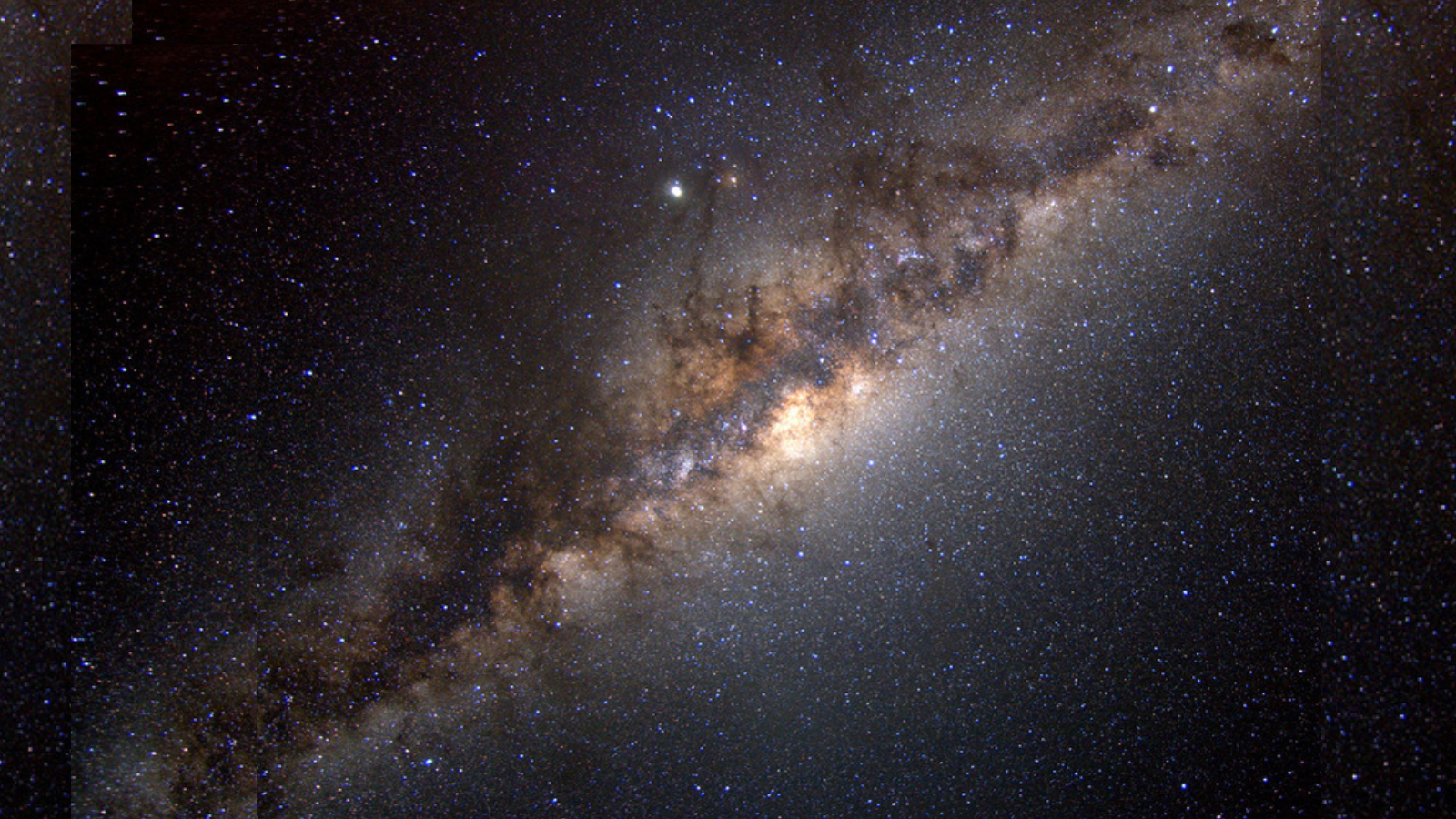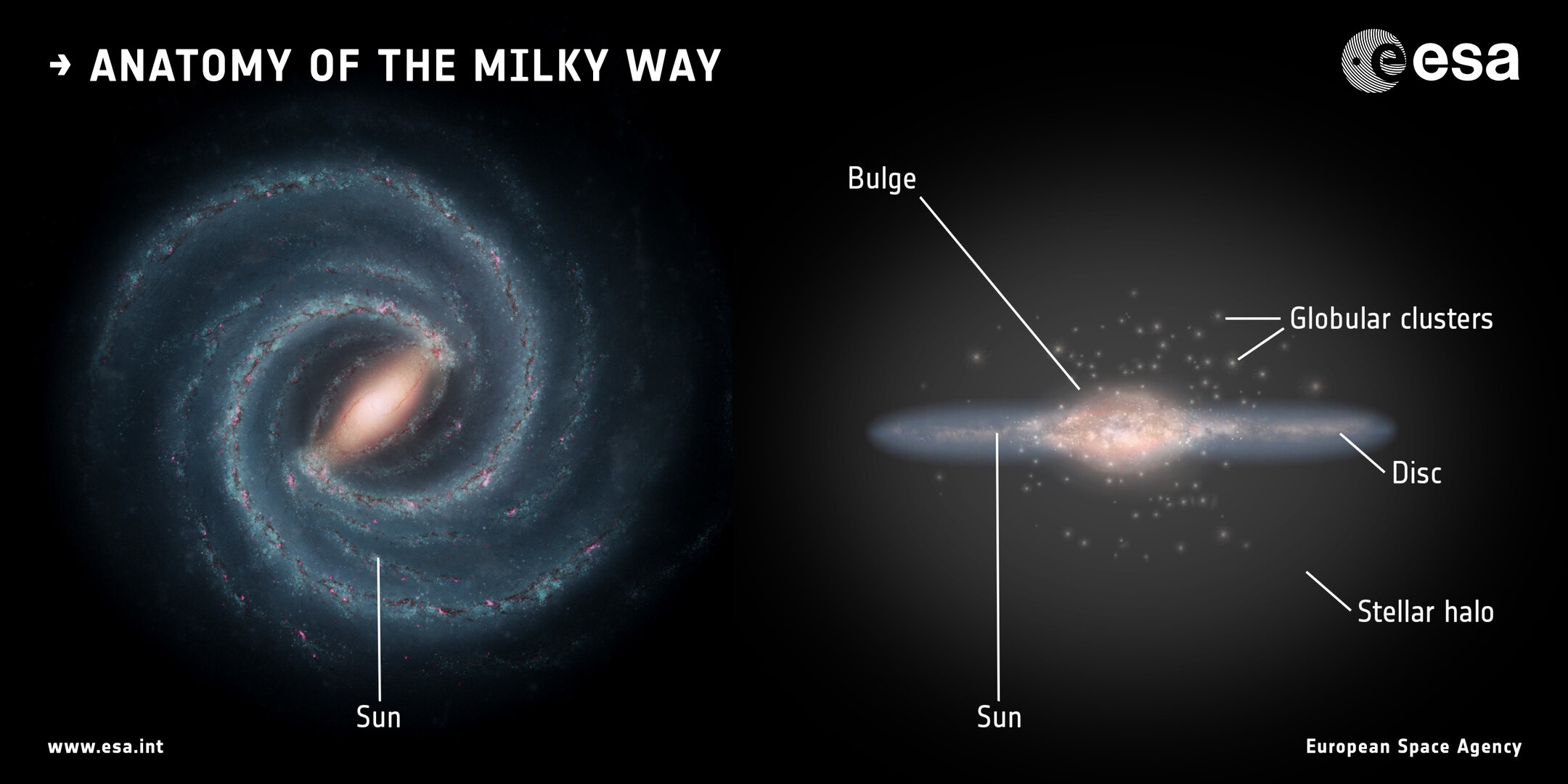In the Milky Way, 3 intruder stars are 'on the run' — in the wrong direction
"They're all quite fast — hundreds of kilometers per second, going the wrong way."

Astronomers have discovered three ancient stars "on the run" in the outskirts of the Milky Way galaxy, racing the wrong way at hundreds of thousands of miles per hour.
Despite being spritely for their age, the three stars are so old that they date back to the formation of the first galaxies. That's between one and two billion years after the Big Bang.
Researchers from the Massachusetts Institute of Technology (MIT) found these stars in the Milky Way's halo, a diffuse cloud made of stars, gas and dust that envelopes our entire galaxy. The team has named the stellar bodies, which have ages between 13 billion and 12 billion years old, "Small Accreted Stellar System, or SASS, stars. The name indicates that each of these stars formed in its own small, primitive galaxy that was later cannibalized by our Milky Way.
The researchers believe there may be more ancient star stragglers existing at the edges of the solar system, forming a sort of "fossil record" that details how our galaxy grew by consuming others and adopting their stars. Such stars could also be used as analogs to study the 13.8 billion-year-old universe's earliest stars and galaxies.
"These oldest stars should definitely be there, given what we know of galaxy formation," team member and MIT professor of physics Anna Frebel said in a statement. "They are part of our cosmic family tree. And we now have a new way to find them."
Discovering more SASS stars would mean more analogs of stars in so-called ultrafaint dwarf galaxies, which are the universe's oldest surviving galaxies. Though these galaxies remain intact, they are too distant and faint to be investigated in detail. Ripped from similar primordial galaxies and absorbed into the Milky Way, SASS stars are, therefore, a more accessible avenue to understanding how some of those very early galaxies evolved.
Get the Space.com Newsletter
Breaking space news, the latest updates on rocket launches, skywatching events and more!
"Now we can look for more analogs in the Milky Way that are much brighter and study their chemical evolution without having to chase these extremely faint stars," Frebel added.
From the classroom to the cosmos
The search for ancient stars at the edge of the Milky Way began in 2022 as part of Frebel's new Observational Stellar Archaeology course. During these sessions, the MIT researcher detailed methods of investigating older stars and discussed how these methods could be applied to unstudied stars to determine their origins.
"While most of our classes are taught from the ground up, this class immediately put us at the frontier of research in astrophysics," Hillary Andales, part of Frebel's lab at MIT's Kavli Institute for Astrophysics and Space Research, said in the statement.
Fredel's students scoured through years of data collected using the 6.5-meter Magellan-Clay telescope at Las Campanas Observatory to find stars of interest, particularly those with low concentrations of elements heavier than hydrogen and helium.
When the first stars formed, the universe was filled with mainly hydrogen, a little helium, and only a smattering of heavier elements, which astronomers call "metals." As these stars lived, they forged metals in the cores, eventually exploding and dispersing elements. Those elements then become the building blocks of the next generation of stars. That means the first stars should have "metal-poor" compositions compared to later stars that have been enriched by previous stellar contributions to the universe's heavy-element manifest.
To identify ancient stars lurking in the Milky Way, students under Frebel's tutelage focused particularly on stars lacking strontium and barium. This led them to three stars that had been observed by the Magellan telescope in 2013 and 2014; they were bodies that had not been very deeply investigated by astronomers.

Not only did the three stars highlighted by the team lack strontium and barium, but the objects' iron content was also quite low in comparison to more "modern" stars like our 4.6 billion-year-old star, the sun. In fact, for one of the stars, the ratio of iron to helium is 10,000 times smaller than the ratio of the same elements for the sun.
And, sure enough, the chemical composition of the stars not only revealed them to be between 12 billion and 13 billion years old, but it also showed a remarkable similarity to the chemical composition of ancient, ultrafaint dwarf galaxies.
Furthermore, to discover how these ancient stars came to be part of our galaxy, the researchers looked at their orbits and paths across the sky. This revealed the stars to be in three different locations of the Milky Way's halo and sit around 30,000 light-years from Earth.
The origin of the stars as part of galaxies gobbled up by the Milky Way was revealed not just by their metal-poor compositions but also by the fact that they orbit in a different direction to the Milky Way's main disk, and most of its halo. The stars also exhibited random angles and odd trajectories that have persisted for billions of years.
In investigating this retrograde motion, the team discovered another 65 stars showing the same pattern. Those stars also had low strontium and barium contents, but strikingly, they had something else in common with the SASS stars, too.
"They're on the run! Interestingly, they’re all quite fast — hundreds of kilometers per second, going the wrong way," Frebel explained. "We don't know why that's the case, but it was the piece to the puzzle that we needed and that I didn’t quite anticipate when we started."
There are around 400 billion stars in the Milky Way, and Frebel and colleagues will now search for more SASS stars among them. They'll do this by looking for metal-poor stellar compositions, then checking if the selected subjects have orbits that don't match galactic flow. Additionally, Frebel's Observational Stellar Archaeology course will be back next year, allowing more students to learn about her intriguing methodology. These results, in a way, are its validation.
"It's been awesome to work with three women undergrads. That's a first for me," Frebel concluded. "It's really an example of the MIT way. We do. And whoever says, 'I want to participate,' they can do that, and good things happen."
The team's results were published on May 14 in the journal Monthly Notices of the Royal Astronomical Society.
Join our Space Forums to keep talking space on the latest missions, night sky and more! And if you have a news tip, correction or comment, let us know at: community@space.com.

Robert Lea is a science journalist in the U.K. whose articles have been published in Physics World, New Scientist, Astronomy Magazine, All About Space, Newsweek and ZME Science. He also writes about science communication for Elsevier and the European Journal of Physics. Rob holds a bachelor of science degree in physics and astronomy from the U.K.’s Open University. Follow him on Twitter @sciencef1rst.
-
Unclear Engineer The first question that comes to me about this article has to do with the orbital speed and direction. How does it compare to the speeds of other stars that rotate in the "normal direction" at about the same distance from the center of our galaxy? Can we tell if these orbits are approximately circular or highly elliptical?Reply -
arturo.v.dominguez@gmail. We have what we call rogue planets, and what we call rogue comets. Each with its own peculiar characteristic for having been assigned that adjective. Perhaps now we a captive rogue star. I say perhaps because I have to assume that it is way too early to tell that they have indeed been captured by our Milky way.Reply -
mcswell I think we should call them Oley Stars. Why, you ask? I'm glad you asked!Reply
Oley was driving home from work one night, when his wife Lena called him on his cell phone. "Oley, you be careful out there!" she said. "The radio, they say someone is driving the wrong vay on de freevay."
Oley answered, "Yah, sure, if dere's one dere's a tousand." -
arturo.v.dominguez@gmail. In this trio of stars, I conclude that one of them, Oley, is in the driver's seat. So does that make the other two companions, abductees; or maybe even a mini posse out to try and corral the escapee.Reply -
Torbjorn Larsson A SASSy find, no doubt.Reply
The paper show kinematic simulations of the 3 initial SASS stars based on their current orbital parameters. Their orbits vary from circular to highly elliptical.Unclear Engineer said:The first question that comes to me about this article has to do with the orbital speed and direction. How does it compare to the speeds of other stars that rotate in the "normal direction" at about the same distance from the center of our galaxy? Can we tell if these orbits are approximately circular or highly elliptical?
In general the disk stars form from cold gas clouds which by their nature of being cooled has assembled in the gravitational well midplane of the halo. Such stars tend to have similarly kinetically calm circular orbits. Halo stars are captured from exogalaxies during Milky Way merger assembly, or ejected from multistellar systems/supernovas/galaxy core, and they will tend to have elliptical orbits and for exocaptures about half will be retrograde.









